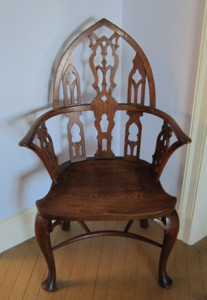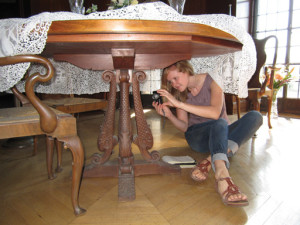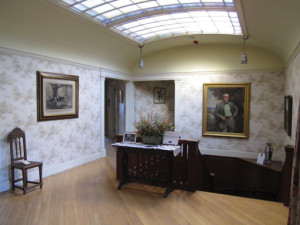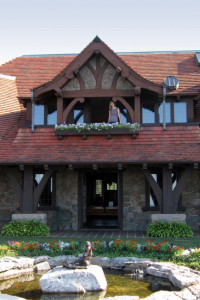Lucknow, Moultonborough, NH
EMERGING SCHOLARS > SUMMER RESEARCH GRANTS
By Kati Schmidt
“The outstanding value of ‘Lucknow’ is the handwork of nature; all the wealth and knowledge of man cannot create its equal.”1 Thomas Gustave Plant published this claim about his New Hampshire home in a sales brochure in the early 1930s.
It advertises Plant’s estate, called Lucknow, which features the mountaintop bungalow that is the focus of my study. Nearly a century after it was built in 1913–1914, Lucknow survives with much of the original Plant décor and furnishings intact. The interiors of Lucknow were furnished by the top decorators of the period with pieces of the highest quality, showing that Plant was aware of trends and the status certain firms would lend his home. The architecture and design of Lucknow are the products of: bungalow literature of the period, Thomas Plant’s European interests, architect J. Williams Beal’s early career, and, ultimately, the unmatched landscape that surrounds it.
Lucknow is the most significant residential commission by the J. Williams Beal firm. Beal’s career began in 1877 when he worked as a draftsman for Richard Morris Hunt before moving to McKim, Mead, and White. Despite his early work with these well-known architects, Beal’s independent career never garnered much recognition in the period.
It is unclear why Plant commissioned Beal for the project, but the partnership proved to be fruitful. Although no primary documents survive from the planning and construction of Lucknow2, it is clear that Beal and Plant collaborated throughout the project. Beal’s wife, Mary, kept a diary, noting her husband’s and sons’ trips to meet Plant beginning in late November 1912 and continuing through July 1915, when the account was settled.3 The local newspaper also commented on the frequency of Beal’s visits, noting in an account of the construction, “the architect, who gets $100 every time he comes up from Boston to see how work progresses… manages to be needed about twice a week.”4
These statements document the partnership between Beal and Plant on the most significant building project for both men. Lucknow is noteworthy among historic houses due to its surviving furniture, hardware, and fixtures. The “leading New York and Boston houses,” including Irving & Casson-A.H. Davenport Company, Edward F. Caldwell Company, and Tiffany Studios, outfitted the interiors.5 Plant ordered custom suites and pieces of furniture in addition to more standard products. Several of these suites of furniture original to the house are still in place, making Lucknow ripe for research into the early twentieth-century bungalow aesthetic on a grand scale. The pieces he chose not only reveal his personal aesthetic but also show how Plant and his wife lived at Lucknow. This document of one man’s fortune and interests opens up a dialogue about typical architecture, interiors, and practicalities of the period, fitting this extraordinary home into a context of domesticity in the early twentieth century.
Research grant provided by the Decorative Arts Trust enabled me to travel to New Hampshire for this study. I did extensive research at Lucknow, and also spent time in local libraries and the Carroll County Register of Deeds. Many people have been very enthusiastic and supportive of the project so far. I would like to thank the Trust especially for their support of decorative arts research and this project in particular. My thesis research is ongoing, and questions and comments about Lucknow or Beal are welcome via email to kati@udel.edu.
Footnotes:
1 Thomas G. Plant, Lucknow, (ca. 1932), pages not numbered.
2 The Beal firm continued on after J. Williams’ death in 1919 with several different partners, the latest being J. Williams Beal Sons & Poskus from 1968 to 1980. All records prior to 1978 were destroyed in a warehouse fire in Hingham, MA.
3 Mary Woodbridge Howes Beal, diary, 1912–1915. (Notes of Barbara Barker, Hanover Historical Society, October 26, 2003.)
4“Moultonboro.” The News & Critic (Laconia, NH), July 23, 1913.
SAVE THE DATE
- Special Symposium
“Classical Splendor”
The Philadelphia Museum of Art
November 4, 2016 - New York Antiques Weekend
January 20-21, 2017 - Spring Symposium
Savannah
April 21-24, 2017 - Spring Study Trip Abroad
Scotland
May 14-22, 2017 - Fall Symposium
Hartford & Western Connecticut
September 2017 - Fall Study Trip Abroad
Venice and the Veneto
October 9-16 and 22-29, 2017
By Kati Schmidt
“The outstanding value of ‘Lucknow’ is the handwork of nature; all the wealth and knowledge of man cannot create its equal.”1 Thomas Gustave Plant published this claim about his New Hampshire home in a sales brochure in the early 1930s.
It advertises Plant’s estate, called Lucknow, which features the mountaintop bungalow that is the focus of my study. Nearly a century after it was built in 1913–1914, Lucknow survives with much of the original Plant décor and furnishings intact. The interiors of Lucknow were furnished by the top decorators of the period with pieces of the highest quality, showing that Plant was aware of trends and the status certain firms would lend his home. The architecture and design of Lucknow are the products of: bungalow literature of the period, Thomas Plant’s European interests, architect J. Williams Beal’s early career, and, ultimately, the unmatched landscape that surrounds it.
Lucknow is the most significant residential commission by the J. Williams Beal firm. Beal’s career began in 1877 when he worked as a draftsman for Richard Morris Hunt before moving to McKim, Mead, and White. Despite his early work with these well-known architects, Beal’s independent career never garnered much recognition in the period.
It is unclear why Plant commissioned Beal for the project, but the partnership proved to be fruitful. Although no primary documents survive from the planning and construction of Lucknow2, it is clear that Beal and Plant collaborated throughout the project. Beal’s wife, Mary, kept a diary, noting her husband’s and sons’ trips to meet Plant beginning in late November 1912 and continuing through July 1915, when the account was settled.3 The local newspaper also commented on the frequency of Beal’s visits, noting in an account of the construction, “the architect, who gets $100 every time he comes up from Boston to see how work progresses… manages to be needed about twice a week.”4
These statements document the partnership between Beal and Plant on the most significant building project for both men. Lucknow is noteworthy among historic houses due to its surviving furniture, hardware, and fixtures. The “leading New York and Boston houses,” including Irving & Casson-A.H. Davenport Company, Edward F. Caldwell Company, and Tiffany Studios, outfitted the interiors.5 Plant ordered custom suites and pieces of furniture in addition to more standard products. Several of these suites of furniture original to the house are still in place, making Lucknow ripe for research into the early twentieth-century bungalow aesthetic on a grand scale. The pieces he chose not only reveal his personal aesthetic but also show how Plant and his wife lived at Lucknow. This document of one man’s fortune and interests opens up a dialogue about typical architecture, interiors, and practicalities of the period, fitting this extraordinary home into a context of domesticity in the early twentieth century.
Research grant provided by the Decorative Arts Trust enabled me to travel to New Hampshire for this study. I did extensive research at Lucknow, and also spent time in local libraries and the Carroll County Register of Deeds. Many people have been very enthusiastic and supportive of the project so far. I would like to thank the Trust especially for their support of decorative arts research and this project in particular. My thesis research is ongoing, and questions and comments about Lucknow or Beal are welcome via email to kati@udel.edu.
Footnotes:
1 Thomas G. Plant, Lucknow, (ca. 1932), pages not numbered.
2 The Beal firm continued on after J. Williams’ death in 1919 with several different partners, the latest being J. Williams Beal Sons & Poskus from 1968 to 1980. All records prior to 1978 were destroyed in a warehouse fire in Hingham, MA.
3 Mary Woodbridge Howes Beal, diary, 1912–1915. (Notes of Barbara Barker, Hanover Historical Society, October 26, 2003.)
4“Moultonboro.” The News & Critic (Laconia, NH), July 23, 1913.




